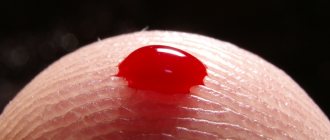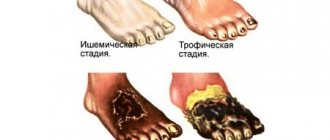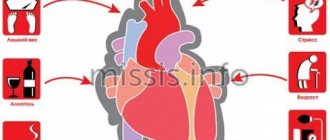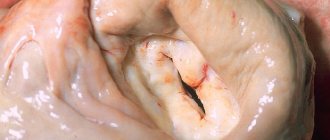Diagnostics and treatment at NEARMEDIC
In most cases, to make a diagnosis, NEARMEDIC cardiologists prescribe standard electrocardiography, Holter (24-hour) monitoring - HM ECG. If there are initial changes on the ECG, pharmacological tests are recommended. In a number of doubtful cases, the doctor prescribes EPI - an electrophysiological study, which helps to develop treatment tactics and determine the electrophysiological indications for pacemaker implantation.
Mild sinus dysfunction does not require treatment. You can limit yourself to monitoring the patient’s condition and conducting non-drug therapy: quitting smoking and alcohol, avoiding taking certain medications. To avoid irritation of the sinocarotid area, it is not recommended to wear tight scarves and ties that put pressure on the neck. Physical therapy classes and swimming are shown.
The most effective treatment for bradyarrhythmia, regardless of its classification, is cardiac pacing. The patient undergoes a mini-operation - a pacemaker is implanted that generates electrical impulses. The operation is performed under local anesthesia.
“Only the heart of a sick person beats like a clock” James Mackenzie, 2010. “With the help of the pulse one can recognize the existence of a disease in the body and foresee future ones.” Herophilus of Chalcedon, c. 335 BC In my opinion, every parent should be able to count the pulse (the number of heart beats in 1 minute). This can be done by pressing large vessels, usually with the index, middle, and sometimes ring fingers. The pulse can be examined in the shoulder, femur, popliteal region, on the back of the foot, and on the temples. But it is most convenient on the radial artery - on the lateral side of the wrist.
In emergency situations, carotid pulse examination is often used: on the carotid artery, located in the neck, below the hyoid bone and outward from the thyroid cartilage (see picture).
With this measurement method, the artery should be gently palpated while the person being examined is sitting or lying down. Excessive compression of the carotid arteries can lead to fainting or cerebral ischemia. You cannot palpate both carotid arteries at the same time! You can learn to count your heart rate through a phonendoscope, but in this case you will most likely need to consult a specialist, since two tones are heard and you need to distinguish which one is the first, according to which the heart rate itself is calculated. The number of vascular oscillations is calculated in 15 seconds and multiplied by 4, or in 10 seconds and multiplied by 6. So, we will assume that you already know how to count your baby’s pulse. Increased heart rate (tachycardia). Due to the elasticity of the chest and the thin subcutaneous fat layer in a child, even with a slight increase in heart rate, you can see vibration of the anterior chest wall, synchronous with the contraction of the heart, which sometimes frightens parents. A growing body requires intense metabolism and a high need for oxygen. Therefore, the younger the child, the higher his heart rate. Everyone knows this. But where is the limit, exceeding which is no longer the norm? This is an important question that causes concern among many parents. Heart rate norms at rest and after exercise are different. The stress for an infant is feeding, crying, and physical activity. For older people – walking, running, strong emotions (both positive and negative).
Heart rate norms in children at rest.
Table N1 shows the percentile distribution of heart rate by age - from 25‰ to 75‰ - this is the norm. From 75‰ to 98‰ – tachycardia, above 98‰ – severe tachycardia, which, as a rule, is always pathological. Heart rate after exercise is determined by the formula: (220-age) x 0.85. For example, for a 3-year-old child this is (220-3)x0.85 = 184 beats per minute (for comparison, up to 137 is allowed at rest). For the most meticulous parents: if you have calculated and received a figure that exceeds the specified standards by 1-5 strokes, do not worry. In addition, you could have made a mistake; it makes sense to measure several times. All standards are average values and a small deviation is quite acceptable. In addition to the number you received when calculating the pulse, the general condition of the child must be taken into account: if he is active, cheerful, with a normal skin color, there is most likely no reason for concern. In addition to the pulse rate, many parents pay attention to its rhythm. An irregular pulse in a child associated with breathing is normal. If you can ask your baby to hold his breath for a while, the pulse immediately becomes more rhythmic.
NB! If the pulse significantly (by 10-20 or more beats) exceeds the norm, if its irregularity is not associated with breathing, the child is pale, lethargic, the nasolabial triangle is gray, shortness of breath is a reason to consult a doctor. Registration of a pathologically rapid pulse is not necessarily associated with problems of the cardiovascular system, but also with pathology of other internal organs, especially the gastrointestinal tract and endocrine system. In routine practice, most often, this is the debut of some acute infectious disease that has not yet manifested itself. Decrease in heart rate (bradycardia). As a practicing pediatrician and cardiologist, I can say that over the past 10 years the number of children with a pulse lower than average has increased significantly. There is no evidence base for this phenomenon in the medical literature available to me, so I can only assume that this may be the result of widespread physical inactivity and a passion for gadgets, which we will talk about in a separate conversation. If a rare pulse is detected, this is a reason to contact a pediatric cardiologist. But don’t be surprised if the doctor, instead of the treatment you expected, advises you to move more, stay outdoors and control this situation.? Sometimes medications are prescribed, but their effectiveness has not been proven. Considering that with age the pulse should physiologically become less frequent, a child with bradycardia may experience a pathological decrease in pulse rate, which should not be missed.
Children with a low pulse often experience headaches, dizziness, increased fatigue, and poor tolerance to physical activity. The boundaries of moderate and severe bradycardia are presented in Table N2. NB! : Fainting (syncope) or presyncope (presyncope) is a reason to immediately seek medical help. Most of these situations, especially in adolescence, are not dangerous, but there are a number of pathological conditions that require immediate treatment.
Table N2. Interpretation of changes in heart rate (beats/min) in children 5-18 years old (protocol TsSSSA FMBA of Russia) A few words about the modern capabilities of instrumental pulse recording: 1. The standard ECG, known to everyone, is limited to 30-40 seconds of recording, but due to the simplicity and accessibility is indispensable in this matter. 2. Daily (Holter) monitoring (HM) ECG provides information about each heartbeat during the day, its variability during sleep and wakefulness, stress and rest. At the same time, an observation diary is kept and, if it is sufficiently informative, it is possible to prove or reject the connection of complaints with changes in the ECG. This is the “gold standard” for diagnosing heart rhythm and conduction disorders at any age, starting from birth. It is very important to know that the norms determined at rest differ significantly from the norms for daily monitoring, since a larger range of changes is allowed per day. I will not cite them, since they are the domain of specialists. 3. External monitors, so-called Event recorders, can be attached to the surface of the body for 7 to 28 days, and to register an ECG it is necessary to press a button when there are symptoms. 4. Reveal - a device implanted under the skin, resembling a flash drive - is used if there are threatening symptoms, but nothing can be registered on the HM ECG. Such a device can remain under the skin for up to two years.
When recording a rare pulse on an ECG, it is useful to conduct a test with physical activity, when the ECG is recorded at rest (lying down), after a load of 30 squats for 20 seconds) and 3 minutes after the load. A simple but very informative test: if the pulse increases adequately to the load, is restored in a timely manner and there are no pathological changes on the ECG, then, as a rule, there is no cause for concern. The load test can also be carried out using special devices - treadmill test, bicycle ergometer, etc.
The article was prepared by medical cardiologist N.N. Konopko.
Treatment of bradyarrhythmia in children
Bradyarrhythmia in children can be primary or secondary. The latter is a consequence of the presence of other diseases in the body - liver disease, pulmonary edema, intracranial hematoma. For example, bradyarrhythmias in newborns almost always occur against the background of severe damage to the central nervous system.
Children and adolescents with a hereditary predisposition, vegetative-vascular dystonia, and thyroid dysfunction are most susceptible to bradyarrhythmia. In moderate or severe forms, treatment is reduced to taking antiarrhythmic drugs. If a child loses consciousness due to interrupted blood flow to the brain, the doctor will prescribe electrical stimulation.
Respiratory bradyarrhythmia is especially pronounced in children and adolescents. Fortunately, in most children, the decrease in heart rate is temporary; bradyarrhythmia is asymptomatic and easily corrected. In this case, treatment is not required, the disease recedes over time.
All children with bradyarrhythmia should be under the supervision of a pediatric cardiologist, even in the absence of complaints.
Physiological sinus bradycardia - causes:
1. Sleep
In sleep, the whole body rests, including the heart. It, of course, does not stop completely, but it slows down and this is important for proper rest of the whole body and the heart itself. After all, the heart is an organ that works around the clock. With different activity, depending on the time of day.
The night is called the “kingdom of the vagus”, since it is at night that less adrenaline is produced, and the hormone norepinephrine mainly works and is characterized by a pulse-suppressing effect. This is an adaptive (protective mechanism) given to us by nature and it allows the “eternal worker” - the heart - to rest.
2. Clamping of large vascular-nerve bundles
(on the shoulder, hip) with a long-term non-physiological position (sitting at an angle, prolonged awkward position of the arm)
And in the event of a damaging effect, a reflex decrease in heart rate occurs. This goes away without a trace when the influence of the provoking factor ceases. For example, compression of the neurovascular bundle by a hematoma, mechanical compression in a forced position (working at an angle, sitting at an angle).
3. Systematic exercise (compensatory or adaptive bradycardia)
Any sport is an adrenaline rush. To protect the body from excessive exposure to this hormone, norepinephrine (anti-adrenal hormone) begins to be produced compensatoryly over time.
This is accompanied by a number of signs, including the formation of a rare pulse - bradycardia. In this case, the heart is ready for sports stress, works smoothly and economically, and wears out less. The last position is relative, big sport always means heart problems.
The fact is that all large vessels in the body (femoral, brachial artery) are intertwined with small thin branches of the autonomic (peripheral) nervous system.
4. Excessive tone of the parasympathetic nervous system (so-called vagotonia)
In some people, norepinephrine dominates in the body from birth and this condition is called vagotonia.
A person has a central and peripheral nervous system. The peripheral nervous system is a “braid” of all internal organs and blood vessels. And normally, two nerves approach each vessel and internal organ - adrenal and noradrenal.
If the adrenal system dominates, then this is usually manifested by an increased pulse (tachycardia), excessive sweating, and excessive excitability. If the norepinephrine system prevails, the patient has a rare pulse and is prone to sweating and chilliness. Often suffers from pathology of the gastrointestinal tract (typical signs of vagotonia).
5. Eating too much food.
The mechanism of development of bradycardia in this case is similar to all the positions listed above.
6. Carotid sinus syndrome
– reflex bradycardia due to compression of the carotid artery and the so-called carotid sinus located next to it. This reflex is used for tachyarrhythmias, when massage of the area where the carotid artery is located reflexively reduces the pulse.
How dangerous is the disease?
In most cases, cardiac arrhythmia in a child has a favorable prognosis and is benign. However, for any form of the disease, it is extremely important to monitor the baby’s health, regularly conduct preventive examinations and, according to the doctor’s decision, undergo treatment.
In the absence of competent and timely treatment, the pathology can cause serious complications in the future. The long course of the disease has a detrimental effect on the functioning of the heart and leads to dangerous consequences.
Arrhythmia can cause heart failure and cardiomyopathy, which carry the risk of early disability and even death. Increases the risk of developing arterial hypotension and myocardial ischemia. A prolonged attack of tachycardia can provoke cardiogenic shock or acute heart failure with pulmonary edema.
In addition, the long-term chronic course of the pathology significantly worsens the child’s well-being. The quality of life is gradually decreasing, and constant fatigue and apathy only increase over the years Source: Dubovaya A.V. Modern approaches to assessing the quality of life of children with arrhythmias Russian Bulletin of Perinatology and Pediatrics, 2016; 61:5, pp. 75-81.
Symptoms of cardiac arrhythmia in a child
The symptoms of heart rhythm disturbances have different specifics and differ in children of different age groups.
Arrhythmia in a newborn baby can manifest itself through:
- pale, bluish skin;
- baby anxiety for no apparent reason;
- refusal to eat, breastfeed, or bottle;
- shortness of breath;
- slight or no weight gain;
- problems sleeping, crying.
Arrhythmia in a child aged 6 years and older very often has no symptoms. In such cases, pathology is detected during a routine medical examination. Only sometimes do children exhibit characteristic symptoms of the disease:
- excessive fatigue;
- poor body response to physical activity;
- causeless fainting, dizziness;
- pale skin;
- apathy or increased excitability;
- poor appetite;
- pain in the heart area.
Physiological and pathological bradycardia
Bradycardia can be either physiological or associated with various extracardiac pathologies and heart diseases.
Physiological bradycardia
typical for athletes, especially highly qualified ones, for vagotonic people, people with heavy physical labor, overweight, and reduced emotionality. There may also be a familial tendency for bradycardia. Physiological bradycardia is often moderate, asymptomatic and does not require drug treatment. The following may be recorded on the ECG: sinus bradycardia, rare pauses of up to 2.0 seconds. due to sinoatrial blockade of the 2nd degree, transient atrioventricular block of the 1st degree and isolated episodes of the 2nd degree of type 1 at night.
Bradycardia can occur in various pathological conditions and can be either temporary or permanent.
Bradyarrhythmias
is a group of cardiac rhythm and conduction disorders. It includes sinus node dysfunction, atrioventricular and intraventricular blocks.
Sinus node dysfunction (SND)
- this is a condition when the SG generates and conducts impulses too slowly and the frequency of atrial contraction does not meet the needs of the body. The causes of secondary DSU can be: increased activity of the vagus nerve in various diseases: pathology of the larynx and esophagus, increased intracranial pressure, obstructive sleep apnea syndrome. Also, bradyarrhythmias can occur during acute pain, a sudden feeling of fear, including during medical procedures (neurotransmitter bradyarrhythmias). Other causes of DSU: electrolyte disturbances (hyperkalemia), obstructive jaundice, dysfunction of the thyroid gland (hypothyroidism), acute myocardial ischemia, hypertensive crisis, taking medications (usually beta-blockers or other antiarrhythmics). Treatment in such cases is aimed at the underlying pathology, eliminating, if possible, the causative factor. Quite often, secondary DSUs in clinical practice include sleep apnea syndrome and hypothyroidism.
Hypothyroidism
- one of the most common endocrine pathologies.
The disease is characterized by low levels of hormones produced by the thyroid gland. As a result of hypothyroidism, the body's metabolism is disrupted and heart rate decreases.
The main diagnostic method is to determine the concentration of thyroid-stimulating hormone in the blood. Treatment of hypothyroidism is hormone replacement therapy.
Obstructive sleep apnea syndrome (OSA)
. It is manifested by the presence of snoring, interrupted sleep with short pauses in breathing, and daytime sleepiness. Often detected in patients with obesity, arterial hypertension, and diabetes. Pauses at the end of an apnea episode are recorded on the ECG at night. Diagnostic methods are cardiorespiratory monitoring and polysomnography. Treatment – CPAP therapy, weight loss.
At the heart of primary DSU or sick sinus syndrome (SSNS)
there is an organic lesion of the sinoatrial zone with the development of inflammation, sclerosis and fibrosis in various pathologies:
- age-related idiopathic fibrosis;
- arterial hypertension;
- heart defects;
- surgical trauma;
- myocarditis and pericarditis;
- cardiac ischemia;
- infiltrative diseases;
- collagenosis, etc.
In most cases, the disease occurs in old age, but it can also occur in young people.
SSSU includes a whole range of arrhythmias:
- sinus bradycardia;
- sinoatrial block;
- sinus node failure;
- alternation of paroxysmal atrial fibrillation or atrial flutter with sinus bradycardia and episodes of asystole.
Differential diagnosis is based on identifying symptoms, characteristic signs on the ECG and daily ECG monitoring. Less often, it is necessary to conduct an emergency EPI (a non-invasive method of studying the conduction system of the heart through the esophagus).
Sinus bradycardia - heart rate less than 40 per minute. during wakefulness is an absolute sign of SSSU. Sinoatrial (SA) block is a slowdown or disruption of impulse transmission from the SA to the atrial myocardium. SA blockade of the 1st degree (slowdown, all impulses are carried out) is not visualized on the ECG. SA block of the 2nd degree (some impulses are not conducted to the atrial myocardium) on the ECG is manifested by pauses with the absence of the P wave. SA block of the 3rd degree is a complete block of conduction from the SA to the atrial myocardium, replacement rhythms are recorded on the ECG. Failure (arrest) of the sinus node - periods of asystole for several seconds (there are no P-QRS complexes on the ECG), often accompanied by a short-term disturbance of consciousness.
The main symptoms of the disease include:
- dizziness;
- periodic sensations of heart stopping;
- attacks of rapid heartbeat;
- fainting;
- pain in the heart of a pressing, squeezing nature;
- low tolerance to physical activity, manifested by shortness of breath and weakness.
In case of SSSS, the main method of treatment is the implantation of a permanent pacemaker - a device capable of generating impulses and performing the function of the sinus node.
Treatment of pathology
A moderate course of the disease without pronounced clinical manifestations does not require therapy. Organic, toxic and extracardiac forms of bradycardia require mandatory treatment of the underlying pathology. Patients with a drug-induced disease are prescribed reduced dosages of drugs that slow the heart rate.
In case of severe bradycardia with seizures, surgical intervention is performed. The patient is implanted with an electrical pacemaker, which serves as a replacement for the pacemaker. The frequency of impulses generated by the implant corresponds to the age norm of the patient. A stable heart rhythm leads to normalization of hemodynamics and elimination of oxygen starvation of organs.
Types of bradycardia
At the first examination, a pediatric cardiologist in Saratov will help determine the main type of bradycardia in order to prescribe treatment and supportive procedures in the future. It is customary to distinguish the following types:
- Physiological - especially popular among athletes and does not harm the body. It is often called moderate bradycardia because it is caused by a well-trained heart.
- Absolute - an anomaly in which violations are observed under various circumstances.
- Relative - diagnosed in children under certain stable factors: crying, fever, sports or emotional stress.
Bradycardia in children is often caused by congenital heart disease. The main threat is that if the working rhythm is disrupted, the heart does not pump the required amount of blood, which means that the required amount of oxygen does not reach the brain. Pediatric cardiology in Saratov will select the most effective and supportive therapy for your health. The child will be less tired, will be able to do more physical exercise, and over time may even learn suitable sports.
Diagnosis of sinus bradycardia
It is carried out by recording an ECG and Holter ECG monitoring throughout the day.
Diagnosing sinus bradycardia is not easy. Additional examination may be required - echocardiography (ultrasound of the heart), examination of the abdominal organs, thyroid gland, etc. A cardiologist and arrhythmologist will help the patient with this.
Our clinic “New Hospital” offers examinations necessary for a full diagnosis and selection of the correct tactics for sinus bradycardia.
Treatment of children's ari
Our medical centers provide comprehensive diagnostics and treatment of cardiovascular pathologies in young patients. By contacting SM-Clinic, you can be sure that:
- the child will be treated by qualified cardiologists;
- if necessary, related specialists will be involved in the therapeutic process, who will provide an integrated approach;
- the baby will be examined in a modern diagnostic center with advanced equipment that provides highly accurate results and eliminates the possibility of receiving erroneous data;
- consultations and other procedures will take place at a clearly appointed time, without queues or tedious waiting.
Sign up for a consultation by phone or fill out the feedback form, and we will contact you to confirm your appointment.
Sources:
- Balykova L.A., Nazarova I.S., Tishina A.N. Treatment of cardiac arrhythmias in children. Practical Medicine No. 5 (53), September 2011, pp. 30-37.
- Pavlova N.P., Maksimtseva E.A., Artemova N.M. Arrhythmias in children. Cardiovascular therapy and prevention No. 18, 2021, pp. 118-119
- Dubovaya A.V. Modern approaches to assessing the quality of life of children with arrhythmias. Russian Bulletin of Perinatology and Pediatrics, 2016; 61:5, pp. 75-81
- Skudarnov E.V., Baranova N.V., Antropov D.A., Dorokhov N.A. Structure and etiological factors of cardiac arrhythmias in newborns. Russian Bulletin of Perinatology and Pediatrics No. 3, 2021, p. 183
To treat or not to treat sinus bradycardia?
It depends on its cause in the first place.
If bradycardia occurs while taking medications, then after they are discontinued, as a rule, it disappears and does not require treatment. If bradycardia is persistent, persists for a long time and is poorly tolerated by the patient, then it certainly requires correction, up to the implantation of a pacemaker. In case of mild sinus bradycardia, you can get by with taking Zelenin drops (20-30 drops in warm water 1-2-3 times a day, as needed). Your doctor will provide information on how to treat bradycardia in your case.
You can make an appointment by phone or through the appointment form on the New Hospital website
Signs of illness
Sinus bradyarrhythmia in a child is sometimes asymptomatic and is detected by chance during a comprehensive diagnosis of other diseases. The main signs depend on the age, developmental characteristics of children, and the stage of the disease. Depending on the cause, the problem may be physiological, organic, neurogenic, drug-related or toxic.
Your child may have the following symptoms:
- increased sweating at rest;
- feeling of lack of air;
- loss or confusion of consciousness;
- heaviness in the chest;
- poor appetite;
- low concentration, deterioration in school performance;
- discharge on the face of the nasolabial triangle.
Tingling or burning in the heart with bradyarrhythmia always occurs when exhaling. If you hold your breath for a few seconds, the discomfort disappears.
Physiological
For natural reasons, a slowdown in heart rate is observed during a night's rest or daytime sleep, after waking up. At rest, the pulse drops to 65–60 beats, the changes are practically not felt by the child. During physical activity or active play, the indicator rises to a normal and comfortable level.
Among the dangerous physiological causes of the disease is the appearance of benign or malignant tumors in the heart area, on the myocardial muscle. The child complains of shortness of breath and tingling in the chest, has pale skin, and may lag behind peers in development in terms of weight and height.
Organic
Bradyarrhythmia can form due to improper development of the sinus node in the heart. The number of beats per minute decreases to 45–50 units, and deformation and necrosis of myocardial tissue begins.
The problem occurs against the background of serious diseases:
- vascular ischemia;
- cardiosclerosis;
- cardiomyopathy.
In a young child, sinus bradyarrhythmia of the organic type develops with inflammation of the pericardium of the heart. This is a dangerous complication after a sore throat or otitis media, in which characteristic symptoms are observed: constant low-grade fever, muscle weakness, low activity in play and study, joint pain.
Neurogenic
Sinus bradyarrhythmia in a child can be a consequence of pathologies of the nervous system: intracranial pressure, childhood neuroses, vegetative-vascular dystonia.
In addition to pain in the heart area, young patients feel:
- dizziness;
- low blood pressure;
- attacks of panic or irritability.
The problem requires an integrated approach to treatment, the help of an endocrinologist, cardiologist and neurologist.
Medicinal
In childhood, bradyarrhythmia of this type develops extremely rarely. It occurs in children with asthma, kidney pathologies or severe lung diseases, who constantly take potent drugs to maintain vital functions. Damage to the sinus node of the heart can occur as a side effect after undergoing chemotherapy for oncology.
Toxic
Increasingly, doctors are observing babies who have sinus bradyarrhythmia after toxic poisoning. The reason is associated with living in a disadvantaged area, constant contact with toxic substances in the house, kindergarten, and school. Damage to the heart is caused by pathogenic bacteria and viruses in typhoid fever, hepatitis A or B.
Diagnostics
Doctors identify several acute time periods when the possibility of developing pathology becomes especially acute. Often, arrhythmia in a child develops in infancy, at 4-5 years, at 7-8 years, at 11-12 years and in adolescence. Growth spurts occur during these age intervals. Therefore, carrying out preventive diagnostics and cardiac examination at this time is of particular importance, even if the symptoms of the disease do not manifest themselves.
Only a pediatric cardiologist or arrhythmologist can identify the deviation and establish a diagnosis. Initially, you should consult with a specialized specialist who:
- will study the medical history of a small patient;
- will conduct a full examination, palpation, percussion and auscultation;
- will prescribe the necessary laboratory and instrumental diagnostics.
To identify the disease and record the diagnosis, the doctor prescribes:
- Electrocardiography (ECG) is a method of studying the heart that allows you to record the electrical activity of the heart. With its help, the doctor identifies rhythm deviations and determines the frequency of muscle contraction.
- Daily ECG monitoring is a study of cardiac activity that takes place throughout the day. Compared to ECG, this method is more accurate. Allows you to record the dynamics of the rhythm during different periods of the child’s life: activity and sleep.
- Stress tests – analysis of heart activity during physical activity of varying intensity. Prescribed for suspected cardiac arrhythmia in a child 3 years of age or older.
The diagnostic results allow the cardiologist to diagnose the disease. Additionally, the doctor can prescribe procedures that will help identify the causes of the pathology:
- Echocardiography (EchoCG) is the study of the heart using ultrasound. With its help, you can detect the organic prerequisites for the development of arrhythmia: defects, neoplasms, etc.
- Electroencephalography (EEG) is the study of the electrical activity of the brain. It is prescribed if there is a suspicion of a connection between the pathology and abnormalities in the functioning of the brain.
- Radiography is a study using x-rays. Allows you to detect the preconditions for arrhythmia that are not directly related to the work of the heart: diseases of large vessels, pathologies of the spine, etc.
Is it normal for a child who plays sports to develop the disease?
At the initial stage of bradyarrhythmia, the child leads an active lifestyle. But excessive sports activities in preschool age can provoke disturbances in the development of certain parts of the heart. This causes the appearance of painful symptoms during the transition period.
With regular sports activities in children, in 90% of cases the physiological type of the disease is diagnosed.
With a constant load, the heart gets used to working at an increased pace for several hours a day, so at rest the pulse drops to 60 beats per minute: this is how the body “forces” the myocardial muscles to rest between heavy workouts. This condition does not cause concern among doctors, does not entail dangerous complications, and is detected in 50% of professional athletes, football players, and cyclists.
Questions and answers
What preventive measures can prevent the development of bradycardia?
Sustained heart rhythm disturbances can be avoided by promptly seeking medical help due to intoxication or deterioration in health while taking medications. Patients with a family history are recommended to undergo annual examinations with a cardiologist.
At what age can a person experience symptoms of bradycardia?
Disturbances in the functioning of the heart rhythm driver are possible at any age. The likelihood of developing a stable form increases significantly when a person reaches 65 years of age.







